On November 13, Singapore time, the Bitcoin Next Summit hosted by Bitlayer, a Bitcoin native second-layer project based on Bitcoin finality, was successfully concluded at the IMPACT Exhibition and Convention Center in Bangkok, Thailand. The summit brought together many first-line Bitcoin ecosystem builders and industry leaders, including Eli Ben-Sasson, co-founder and CEO of StarkWare, Ken Liao, founder and CEO of Xverse, Matt, founder and CEO of Lorenzo Protocol, and more than 20 practitioners, including Kevin He and Charlie Hu, two co-founders of Bitlayer, who shared their insights on the forefront of Bitcoin technology and the next upgrade, and discussed in depth the current pattern and development trend of BTCFi.
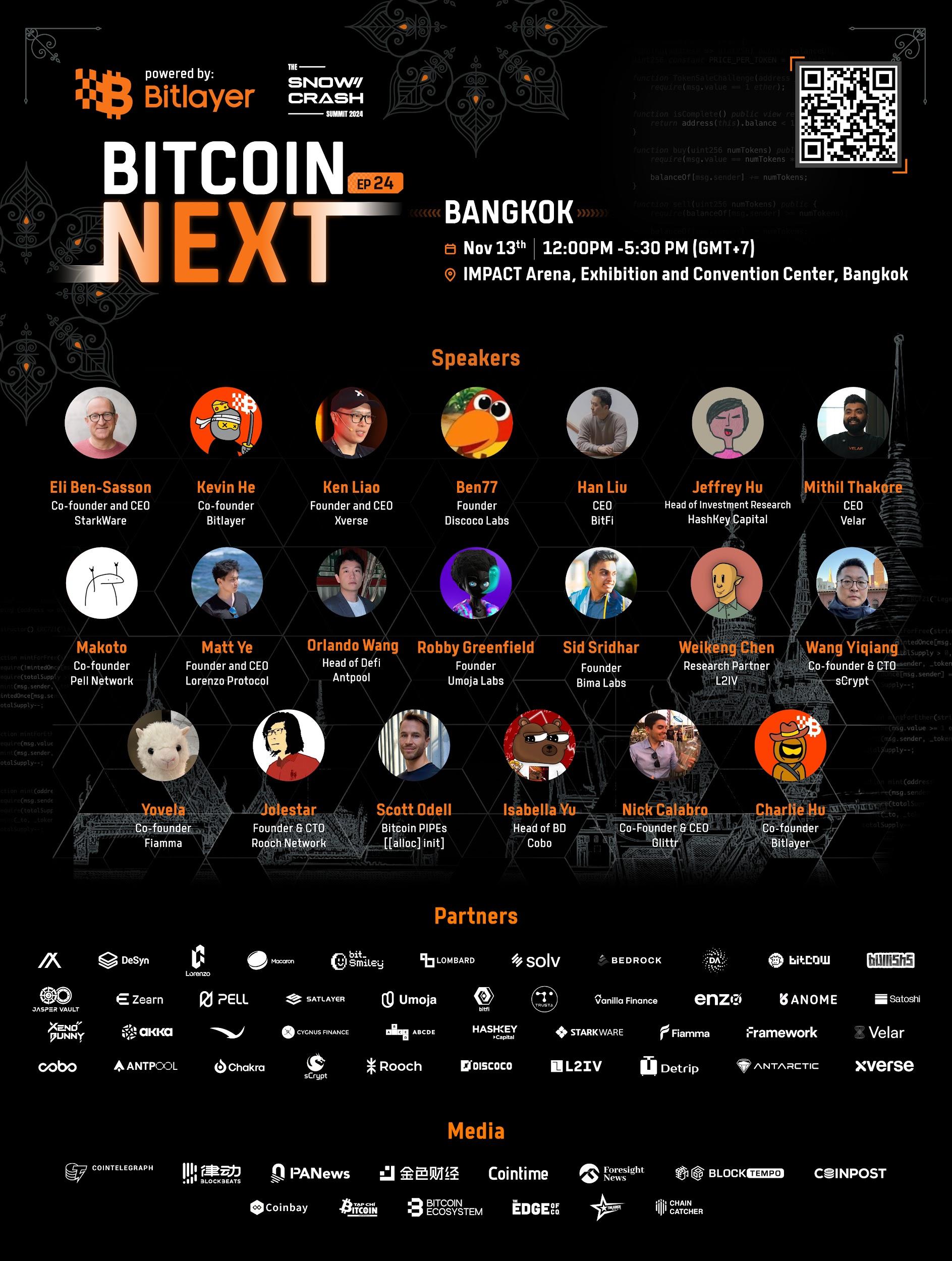
As the most high-profile, influential and profound Bitcoin ecosystem summit in Southeast Asia in recent times, the Bitcoin Next Summit attracted more than 2,000 users to sign up. Five in-depth roundtable meetings were held during the event. The first two roundtables focused on the next upgrade of Bitcoin. The guests discussed in depth the hot community topics, key challenges, solutions and impacts of Bitcoin upgrades. The last three roundtable discussions focused on the popular narrative of BTCFi. The guests believed that BTCFi, which has grown up based on the underlying ecosystem of Bitcoin, has the opportunity to release the financialization potential of native BTC worth billions of dollars and become the next growth engine of the crypto economy.
With its technological innovation and increasingly prosperous on-chain ecosystem, Bitlayer is becoming a leading project in the native second-layer track of Bitcoin and an important force in promoting the Bitcoin financial ecosystem. Through this Bitcoin Next Summit, Bitlayer not only demonstrated its open and cutting-edge attitude, but also injected more possibilities into leading the future development of Bitcoin's second layer.
Bitcoin's Next Upgrade: Current Challenges and Solutions
At the beginning of the conference, Bitlayer co-founder Kevin He delivered a speech entitled "A Brief Report on the Next Bitcoin Upgrade for Non-Professionals". He introduced the differences and characteristics of Bitcoin forks, soft forks and hard forks from multiple dimensions, as well as the impact on stakeholders and the community. Kevin He pointed out that soft forks are considered a more ideal upgrade path because they can avoid the risk of network splits that may be caused by hard forks and maintain the stability and trust of the network. A successful soft fork must find the right balance in the scale of the change, the potential value and risks, and the timing of implementation, while taking into account the incentives and power of different stakeholders.
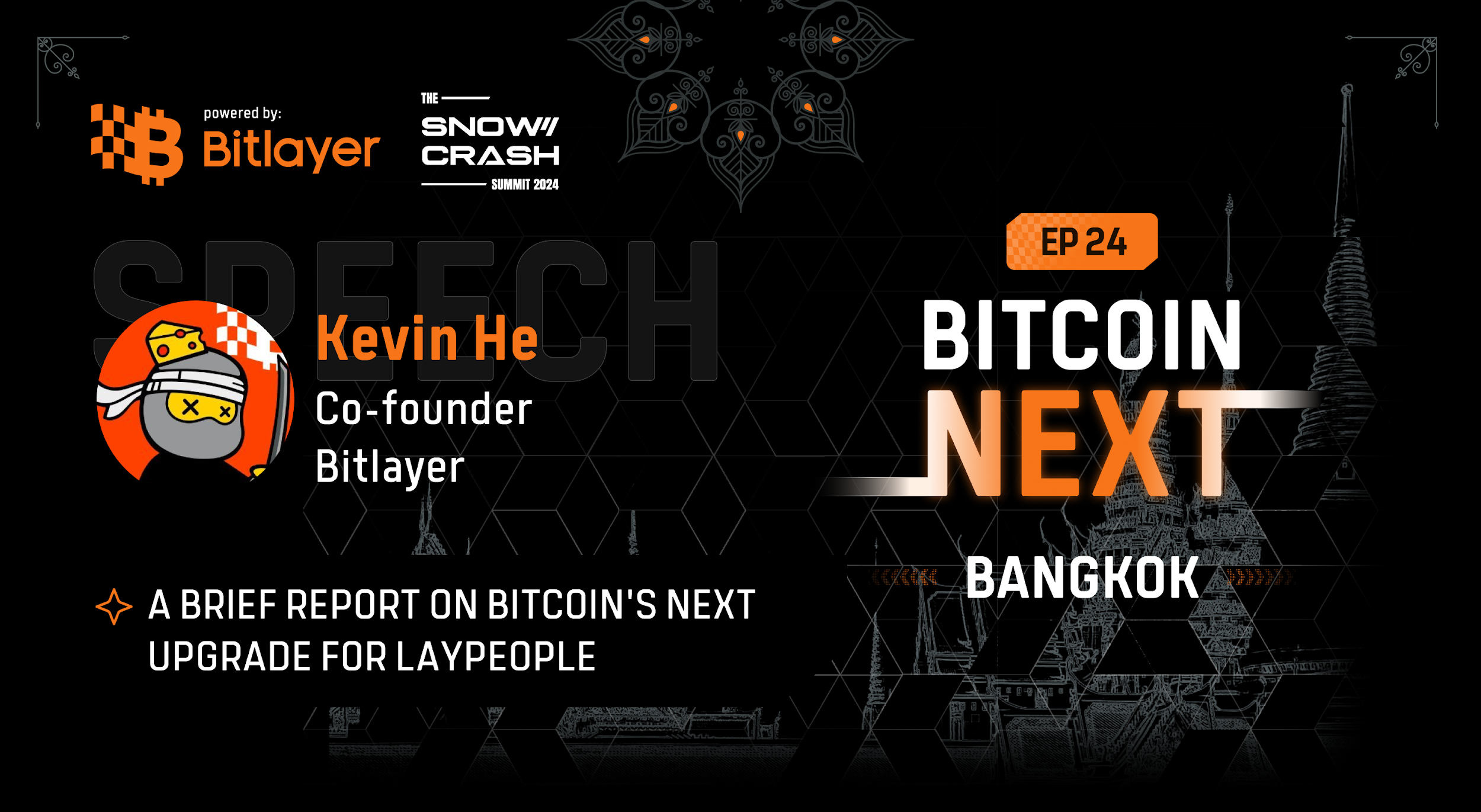
He also mentioned that different stakeholder groups, including protocol developers, investors, users and miners, each have different motivations and influences, which together affect the decision-making of Bitcoin upgrades. He further pointed out that "any changes to the network should adhere to the core values of Bitcoin" and be implemented cautiously under a more complete governance mechanism and at the right time.
Subsequently, StarkWare co-founder and CEO Eli Ben-Sasson delivered a speech entitled "Starknet: Building the Most Secure Bitcoin Layer 2 Network". He said that StarkWare is in a leading position in many fields such as Cairo, Stwo (STARK Two) and Bitcoin research. StarkWare has launched the Stwo validator that supports OP_CAT on the Bitcoin testnet and set up a $1 million research fund specifically for OP_CAT research. In addition, Eli Ben-Sasson emphasized that Stwo is a key advancement. It has features such as M31 field, GKR lookup, Mixed degree and improved Cairo VM, and is expected to be launched on the mainnet in Q1 2025.
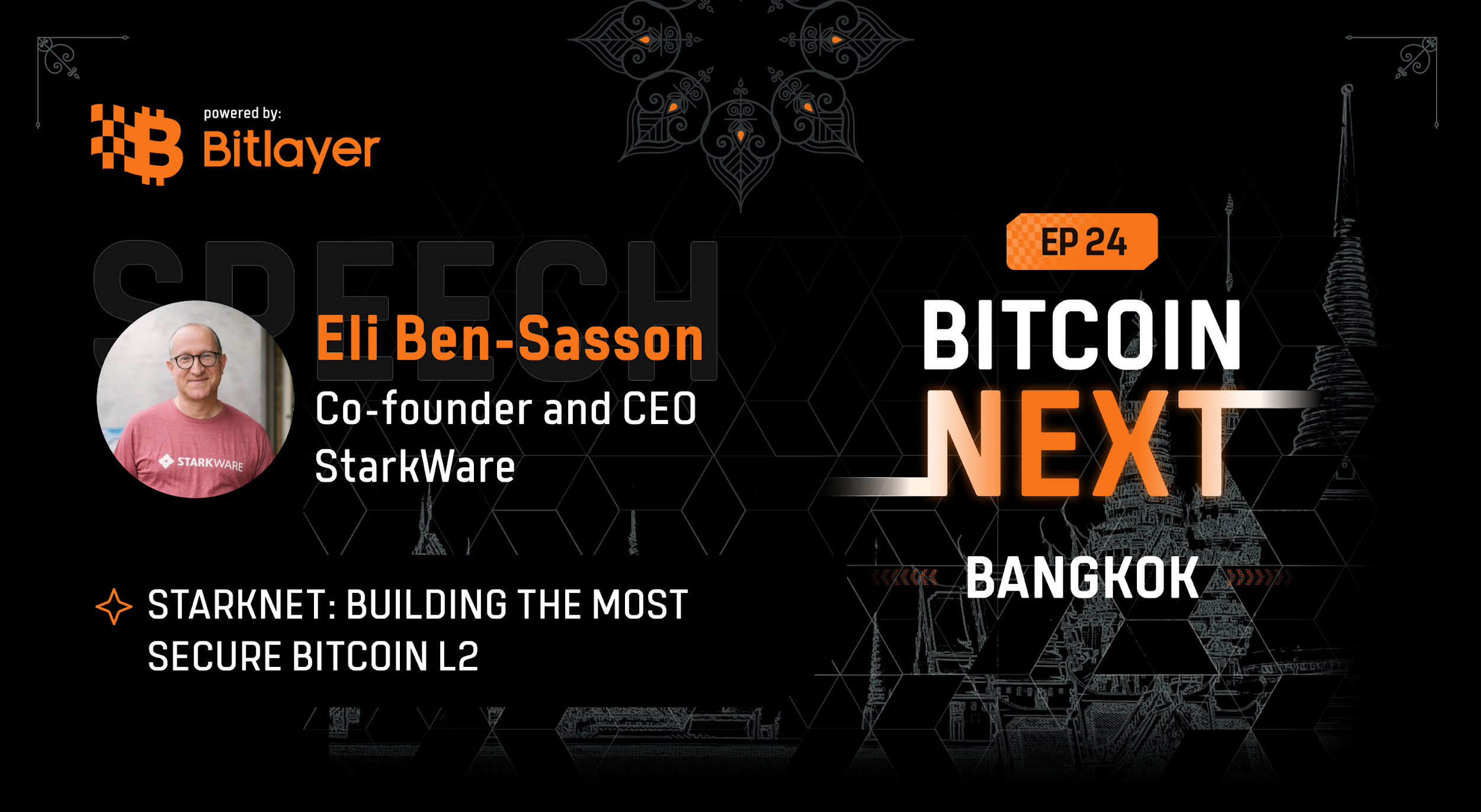
The first roundtable discussion of the conference was on the topic of "Why the next Bitcoin upgrade is important: key challenges and solutions". Josh K, founder of Edge of Bitcoin, served as the roundtable moderator and invited Bitlayer co-founder Kevin He, Xverse founder and CEO Ken Liao, HashKey Capital investment research director Jeffrey Hu, sCrypt co-founder and CTO Wang Yiqiang and Scott Odell from [[alloc] init] as discussion guests.
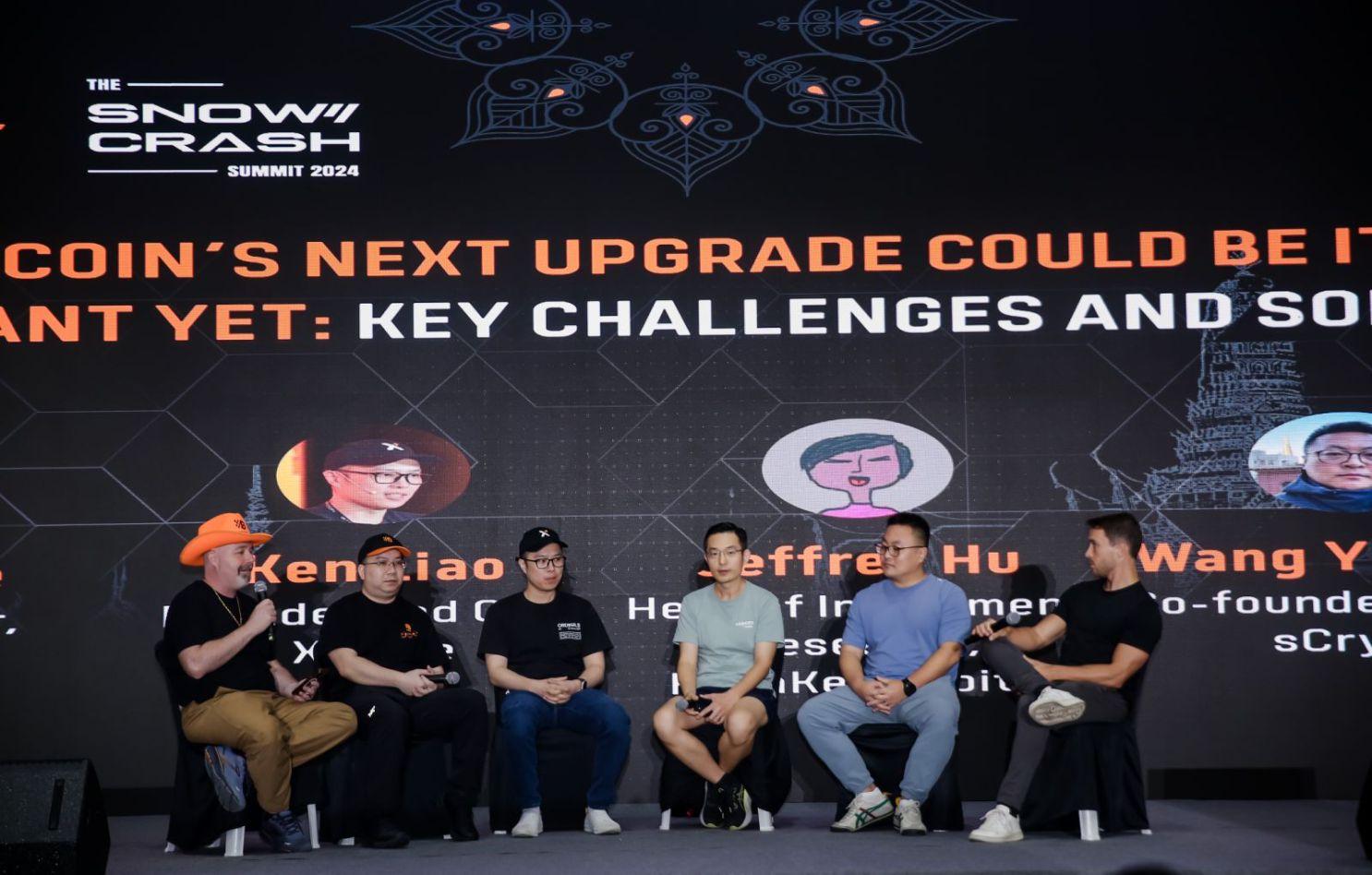
Among them, Jeffrey Hu, head of investment research at HashKey Capital, pointed out that some people believe that Bitcoin will no longer be updated, but in fact Bitcoin has introduced new signature algorithms in the past and is still introducing new cryptographic primitives. Some new proposals are aimed at improving Bitcoin's performance and protecting security, and the community may also actively promote the progress of such plans.
sCrypt co-founder and CTO Wang Yiqiang believes that some Bitcoin opcodes are currently disabled due to security concerns, and their existing performance cannot support more ecological innovations. Therefore, whether to enable certain opcodes (such as OP_CAT) to achieve more functions has become a hot topic in the community. If these proposals are eventually passed, it will bring more innovations to the Bitcoin ecosystem, such as BTCFi and cross-chain interoperability.
Ken Liao, founder and CEO of Xverse, said that there is a lot of room for improvement in the current Bitcoin wallet ecosystem. For example, as the Bitcoin layer is implemented on the mainnet, it will be critical to provide a seamless and unified experience across multiple Bitcoin layer 2 networks. We have the opportunity to improve the fragmentation of the Ethereum layer 2 experience.
Scott Odell, a member of [[alloc] init] and co-founder of the first protocol built with Bitcoin PIPEs, believes that the industry will soon be surprised by the practical opportunities brought by Bitcoin protocol upgrades, which do not require soft forks to be implemented, and new cryptographic technologies such as Bitcoin PIPEs (see @nemothenoone's white paper for details) have opened up a new field that can natively support covenants and ZKPs on Bitcoin by emulating missing opcodes such as OP_CAT, CTV, etc. This will give rise to a new class of Bitcoin-native applications, and will enhance the functionality and programmability of Bitcoin, allowing various protocols to eventually be fully aligned and integrated with Bitcoin L1.
The second roundtable discussion of the conference was on the topic of "From OP_CAT to OP_CTV: What will the next upgrade of Bitcoin bring?" Kevin He served as the roundtable moderator and invited discoco labs founder Ben77, L2IV research partner Weikeng Chen and Fiamma co-founder Yovela as roundtable discussion guests.

Among them, Ben77, founder of discoco labs, emphasized that improvements in Bitcoin's security and user experience are crucial. He believes that the biggest obstacles to Bitcoin's development are speed and cost, and improving user experience requires faster and cheaper transactions.
Yovela, co-founder of Fiamma, shared that her team is about to launch the world's first ZK verification layer driven by BitVM2 and secured by Bitcoin. This groundbreaking technology includes Bitcoin's first functional Groth16 and Fflonk validators and the first complete BitVM2 slashing mechanism, which were completed in August. Fiamma is developing trustless Bitcoin bridge technology that connects BTC L2s, ETH L2s and major L1s, and plans to expand the application of BitVM in the future, including bridge-free interoperability, BRC20 zkindexers, etc. This development will make Bitcoin an indispensable dynamic asset in the future Internet and financial systems, suitable for all ecosystems, DApps, and real-world scenarios such as daily payments.
BTCFi: Unlocking the Trillion-Dollar Bitcoin Economy
BTCFi is undoubtedly one of the hottest topics at the moment. It marks that the concept and application of decentralized finance (DeFi) are expanding to the Bitcoin network, which is expected to unleash the potential of a trillion-dollar crypto financial market.
At the Bitcoin Next Summit, Charlie Hu, co-founder of Bitlayer, delivered a speech titled "Unlocking the DeFi Potential of the Most Secure Blockchain Today", in which he deeply explored the potential of Bitcoin's new frontier and Bitlayer's ecological construction. Charlie Hu pointed out that Bitcoin is seen as a global financial bridge connecting institutions and retail investors, and the East and the West. As Bitcoin's popularity and acceptance continue to increase, it is becoming an important medium for global financial exchanges, promoting the integration of different markets and cultures. He believes that the entire market is undergoing a transition from an institutional bull market to an on-chain retail bull market, and DeFi 2.0 will be staged in the Bitcoin ecosystem.
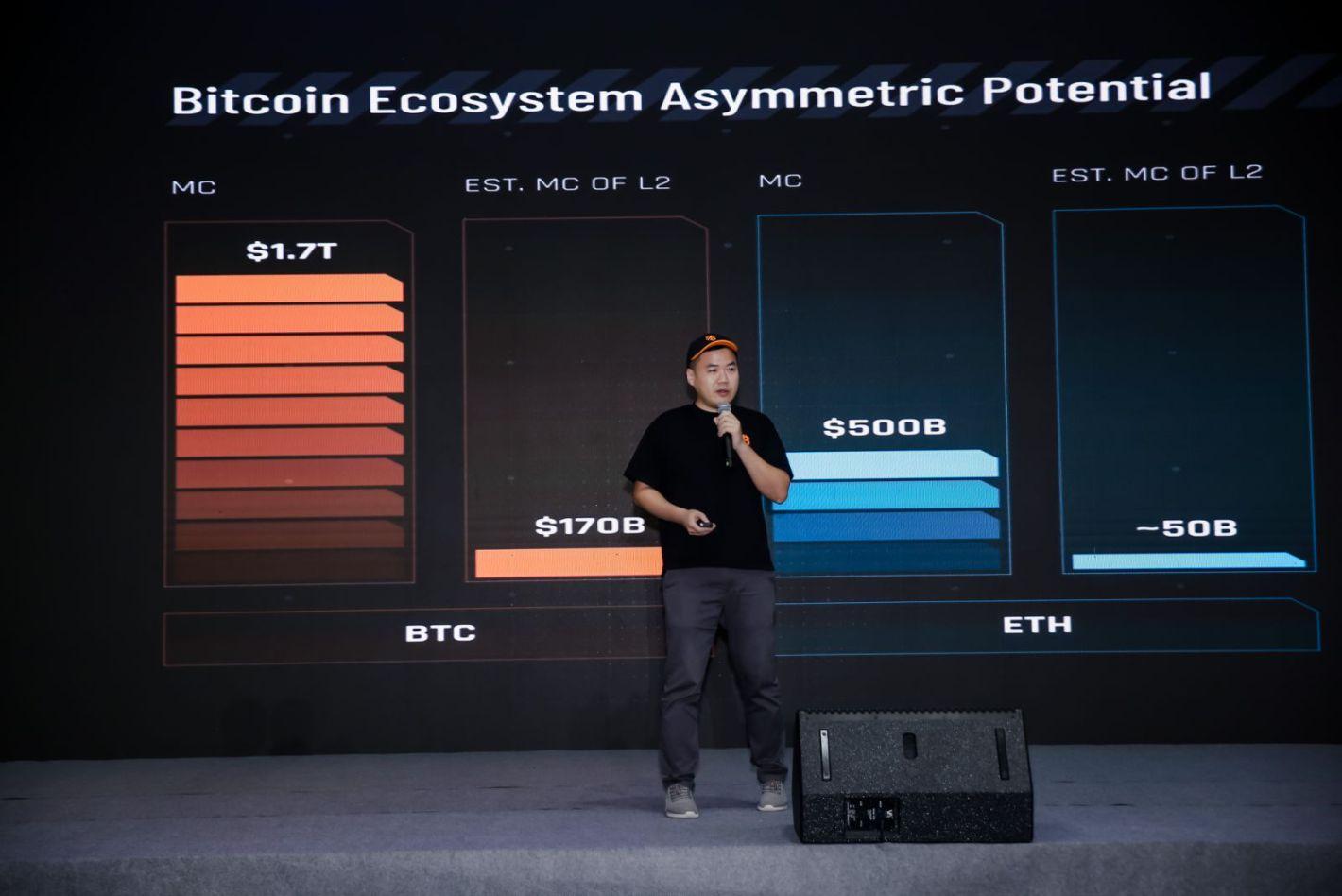
Charlie Hu shared Bitlayer's ecosystem construction methodology with the participants. Bitlayer's ecosystem construction methodology combines the essence of Ethereum's years of experience and the basic principles of Bitcoin's ecosystem. Specifically, Bitlayer's market strategy includes launching the first mining festival, ecological rankings, gamified user centers, ecological project centers, BTCFi stacks, and research strategies. The comprehensive strategy aims to create a Bitlayer ecosystem that is both robust and innovative, and adapts to the evolving market environment and user needs.
Afterwards, Charlie Hu, as the host, started the third roundtable discussion with the theme of "Why DeFi is important to Bitcoin: Leading the growth and challenges of BTCFi". The roundtable invited BitFi CEO Han Liu, Antpool Defi head Orlando Wang and Glittr CEO Nick as discussion guests.
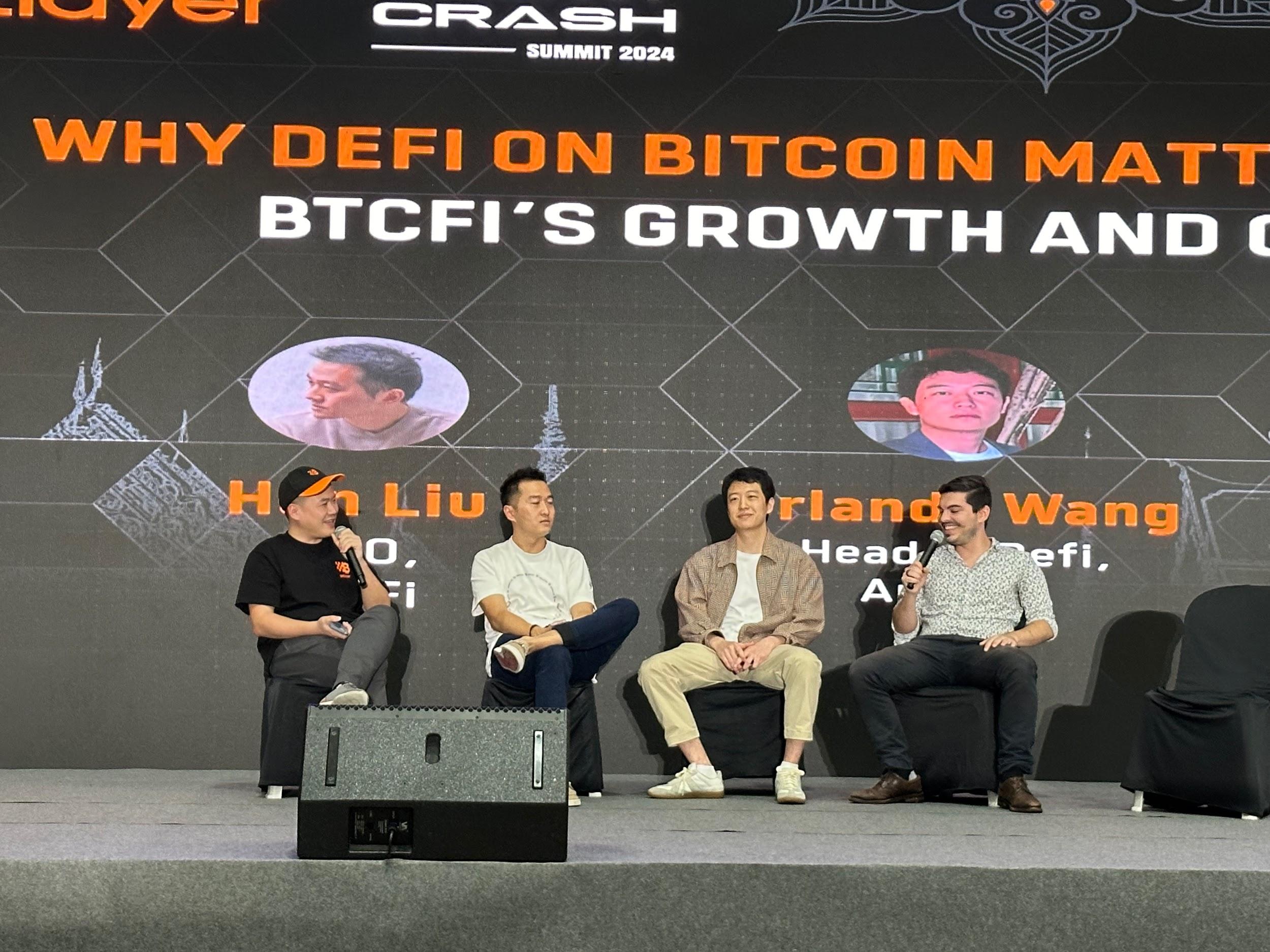
Among them, Orlando Wang, head of Antpool DeFi, believes that BTCFi is still in a very early stage. He believes that compared with high TVL, high trading volume is a more valuable indicator for evaluating the Bitcoin chain ecosystem. High-value scenarios include the flow of millions of US dollars of assets on the chain to meet user lending and other needs.
BitFi CEO Han Liu pointed out that initially, most of the users on the chain were active users, which led to high TVL, but as time went on, TVL no longer played a big role, so people began to change their views. High TVL does not mean project success, and indicators such as user activity and transaction volume are more effective.
Immediately afterwards, the fourth roundtable discussion of the conference was held on the topic of "Exploring Bitcoin DeFi: Opportunities and Innovations Based on Holding Currency". Richard Carthon, head of Edge of Bitcoin BD, served as the moderator of this roundtable and invited Isabella Yu, head of Cobo BD, Mithil Thakore, CEO of Velar, Sid Sridhar, founder of Bima Labs, and Matt, founder and CEO of Lorenzo Protocol, as roundtable discussion guests.
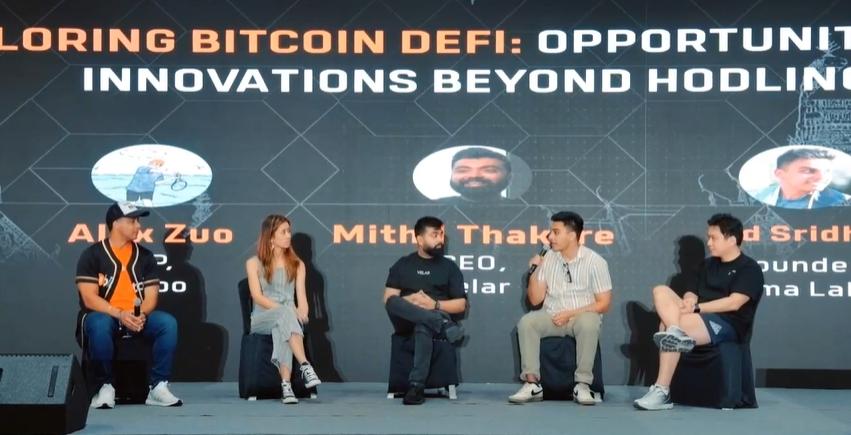
Among them, Sid Sridhar, founder of Bima Labs, pointed out that there are still many hoarded BTCs that have not been activated and used. From different perspectives, this part of BTC can be used for lending, mortgage, trading and other scenarios by supporting different wallet access products or strategies to meet users' trading needs. He emphasized that security issues involving custody, collateral types, cross-chain bridges and hacker attacks are crucial.
Matt, founder and CEO of Lorenzo Protocol, pointed out that there are already projects such as Babylon in the Bitcoin staking track that can provide users with BTC staking to earn returns. In addition, some projects adopt neutral strategies and issue assets such as stBTC, which enable BTC to be adopted on different second-layer chains. Based on this background, the market opportunities we see include aggregators aimed at exploring returns, building multi-layer stacks, etc.
Velar CEO Mithil Thakore believes that BTC involves assumptions such as underlying security, transaction trust, and protocol risks in related applications. His team is focused on building BTC products in a decentralized, non-custodial, and trust-minimized manner, building user-oriented infrastructure, and ultimately benefiting users in a trust-minimized manner.
Isabella Yu, head of Cobo BD, shared with participants how Cobo promotes BTC adoption in a wider range of scenarios. Her team has now reached cooperation with Babylon and multiple re-staking agreements to handle BTC staking through multi-party permission management using the MPC wallet to ensure the asset security of institutional clients.
The theme of the fifth roundtable of this summit was "Building the BTCFi System: Community, Cooperation and Sustainable Development". Max Andonov, BD Assistant of Cointelegraph Accelerator, was invited as the roundtable moderator, and Jolestar, founder of Rooch Network, Robby Greenfield, founder of Umoja Labs, and Makoto, co-founder of Pell Network, were invited as roundtable discussion guests.
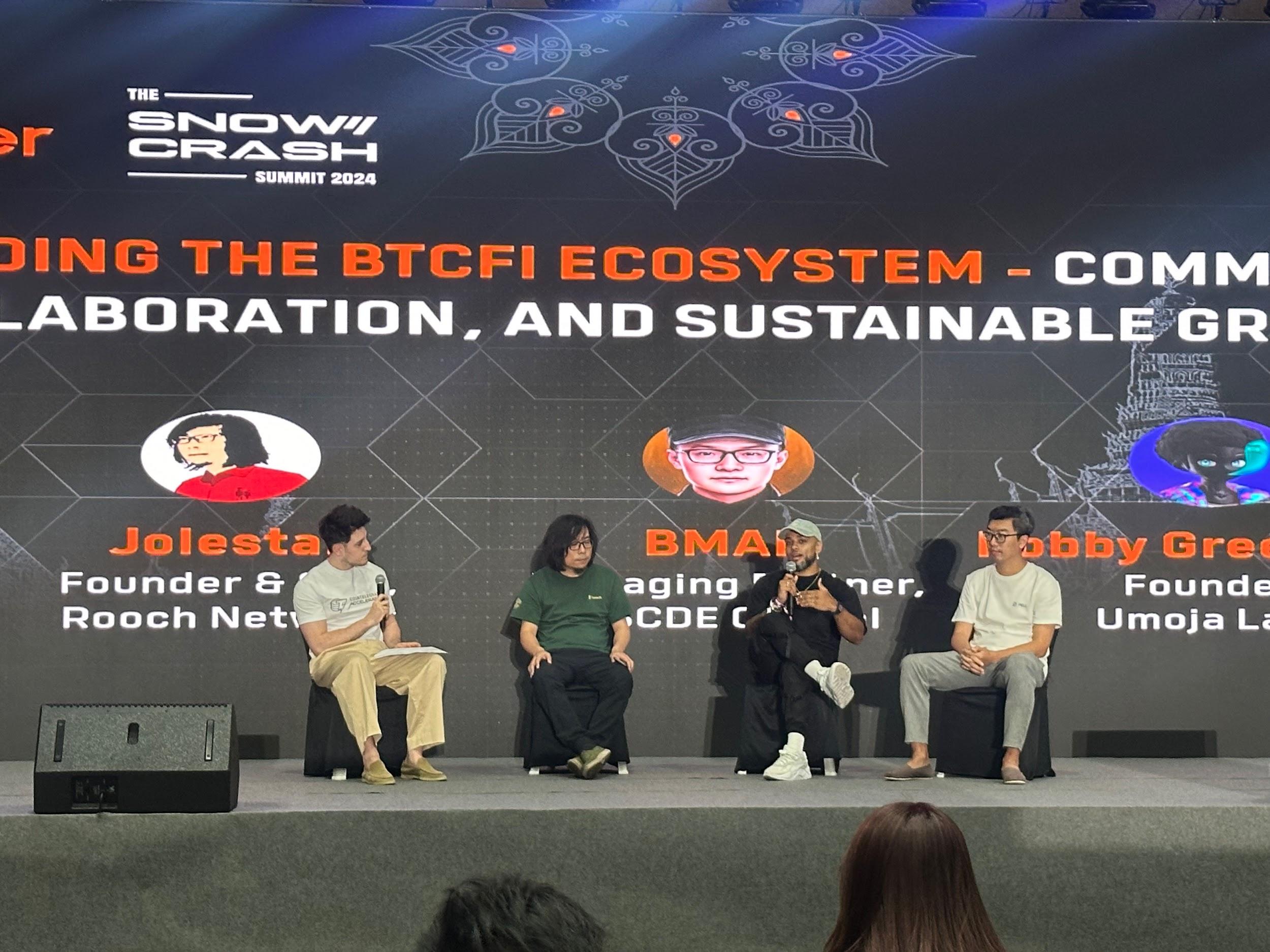
Among them, Umoja Labs founder Robby Greenfield pointed out that BTCFi currently faces problems such as limited scalability, insufficient liquidity and security, making it difficult to benefit from BTC, which currently has the largest market value, and expand its scale. If Bitcoin chain assets can interact with blockchains such as Ethereum and Solana across chains, such as through LayerZero to achieve lending operations between different chains, it will make native BTC more useful. Its team is currently developing a protocol dedicated to high-yield liquidity pledge tokens yBTC.
Makoto, co-founder of Pell Network, shared that the challenges faced by BTCFi products in terms of user adoption include differences in user portraits and changes in traditional mining profit strategies. In the process of market expansion and product acquisition, it is possible to first promote and educate retail users and communities, and then attract institutional attention and adoption after the foundation of this part of the community is solid. In addition, a good marketing strategy includes concise expression, professional content marketing, and clear and reasonable project roadmaps and implementation plans.
Jolestar, founder of Rooch Network, shared that according to his experience, if emerging crypto products want to acquire a wider range of users and non-crypto users, they can achieve user acquisition goals by simplifying products, providing users with free Gas, and trying to attract traffic from social channels such as Twitter and Telegram.
The last part of the conference was the closing speech by Charlie Hu, co-founder of Bitlayer. After expressing great gratitude to all parties who supported the smooth progress of the Bitcoin Next Summit, he also mentioned that the recent Bitcoin price has continuously broken through historical highs and the crypto market sentiment is high. Many developers who continue to build the Bitcoin ecosystem will benefit from this wave and have a bright future. With the continuous prosperity and development of the Bitcoin ecosystem, Bitlayer will witness the history and new chapter of Bitcoin with you.


